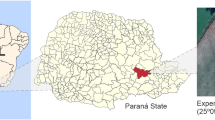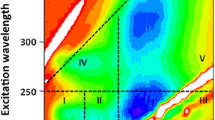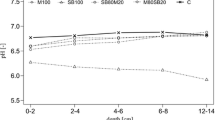Abstract
The dispersive behavior dynamics of clay determine soil characteristics such as permeability and aggregate stability, and, consequently, crop productivity. Soil dispersion is heavily influenced by the ionicity of clay–cation bonds and has been shown to be related to the net negative charge and pH of the system. Little work has been done, however, which considers these factors together, especially for K and Mg clays. The objective of the present study was to investigate the effect of changing pH on the dispersive behavior of Mg and K homoionic clays, in comparison to Ca and Na clays under equivalent pH conditions. The clay fractions used here were extracted from three soils and have distinctly different mineralogies. These clays were treated to become homoionic with regard to Na, K, Ca, and Mg. Excess salts were removed by dialysis and pH was adjusted to 3, 4, 5, 6, 7, 8, 9, 10, and 11 for all clays, except Mg (pH range 3–7). Clay dispersion-flocculation dynamics were investigated, and the net negative charge, pH, electrical conductivity (EC), and turbidity were measured. Mg has a similar but less flocculative effect than Ca, while K has a similar but less dispersive effect than Na, under similar pH conditions. The dispersive behavior of Na, K, Mg, and Ca homoionic clays was correlated well with the ionicity of clay–cation bonds at equivalent pH, with the degree of clay dispersion being explained by the pH, EC, ionicity, ζ-potential, and mean particle size of the clay–cation system. A predictive model for dispersion was developed with its applicability and limitations discussed.





Similar content being viewed by others
REFERENCES
Agassi, M., Shainberg, I., & Morin, J. (1981). Effect of electrolyte concentration and soil sodicity on infiltration rate and crust formation. Soil Science Society of America Journal, 45, 848–851.
Amezketa, E. (1999). Soil aggregate stability: A review. Journal of Sustainable Agriculture, 14, 83–151.
Arienzo, M., Christen, E., Quayle, W., & Kumar, A. (2009). A review of the fate of potassium in the soil–plant system after land application of wastewaters. Journal of Hazardous Materials, 164, 415–422.
Bennett, J. M., Marchuk, A., & Marchuk, S. (2016). An alternative index to ESP for explanation of dispersion occurring in soils. Soil Research, 54, 949–957.
Bergaya, F., Lagaly, G., & Vayer, M. (2006) Cation and anion exchange. Pp. 979–1001 in: Handbook of Clay Science (F. Bergaya, B.K.G. Theng, and G. Lagaly, editors). Developments in Clay Science, 1, Elsevier Ltd., Amsterdam.
Boström, M., Williams, D. R. M., & Ninham, B. W. (2001). Specific ion effects: why DLVO theory fails for biology and colloid systems. Physical Review Letters, 87, 168103.
Bradfield, R. (1936). The value and limitations of calcium in soil structure. Soil Science Society of America Journal, 2001(17), 31–32.
Brigatti, M. F., Galan, E., & Theng, B. K. G. (2006). Structures and mineralogy of clay minerals. Developments in Clay Science, 1, 19–86.
Brown, M. A., Goel, A., & Abbas, Z. (2016). Effect of electrolyte concentration on the stern layer thickness at a charged interface. Angewandte Chemie International Edition, 55, 3790–3794.
Chorom, M., & Rengasamy, P. (1995). Dispersion and zeta potential of pure clays as related to net particle charge under varying pH, electrolyte concentration and cation type. European Journal of Soil Science, 46, 657–665.
Churchman, G. J., & Weissmann, D. A. (1995). Separation of sub-micron particles from soils and sediments without mechanical disturbance. Clays and Clay Minerals, 43, 85–91.
Curtin, D., Steppuhn, H., & Selles, F. (1994a). Clay dispersion in relation to sodicity, electrolyte concentration, and mechanical effects. Soil Science Society of America Journal, 58, 955–962.
Curtin, D., Steppuhn, H., & Selles, F. (1994b). Effects of magnesium on cation selectivity and structural stability of sodic soils. Soil Science Society of America Journal, 58, 730–737.
Dang, A., Bennett, J. M., Marchuk, A., Biggs, A., & Raine, S. (2018). Quantifying the aggregation-dispersion boundary condition in terms of saturated hydraulic conductivity reduction and the threshold electrolyte concentration. Agricultural Water Management, 203, 172–178.
Delgado, A., Gonzalez-Caballero, F., & Bruque, J. M. (1986). On the zeta potential and surface charge density of montmorillonite in aqueous electrolyte solutions. Journal of Colloid and Interface Science, 113, 203–211.
Derjaguin, B. V. (1941). Theory of the stability of strongly charged lyophobic sols and the adhesion of strongly charged particles in solutions of electrolytes. Acta Physicochimica USSR, 14, 633–662.
Emerson, W. W., & Chi, C. L. (1977). Exchangeable calcium, magnesium and sodium and the dispersion of illites in water. II. Dispersion of illites in water. Soil Research, 15, 255–262.
Frenkel, H., Goertzen, J. O., & Rhoades, J. D. (1978). Effects of clay type and content, exchangeable sodium percentage, and electrolyte concentration on clay dispersion and soil hydraulic conductivity. Soil Science Society of America Journal, 42, 32–39.
Goldberg, S., & Glaubig, R. A. (1987). Effect of saturating cation, pH, and aluminum and iron oxide on the flocculation of kaolinite and montmorillonite. Clays and Clay Minerals, 35, 220–227.
Goldberg, S., Kapoor, B. S., & Rhoades, J. D. (1990). Effect of aluminum and iron oxides and organic matter on flocculation and dispersion of arid zone soils. Soil Science, 150, 588–593.
Goldberg, S., Forster, H. S., & Heick, E. L. (1991). Flocculation of illite/kaolinite and illite/montmorillonite mixtures as affected by sodium adsorption ratio and pH. Clays and Clay Minerals, 39, 375–380.
Greene, R., Posner, A., & Quirk, J. (1973). Factors affecting the formation of quasi-crystals of montmorillonite. Soil Science Society of America Journal, 37, 457–460.
Greene, R., Posner, A., & Quirk, J. (1978). A study of the coagulation of montmorillonite and illite suspensions by calcium chloride using the electron microscope. In W. W. Emerson, R. D. Bond, & A. R. Dexter (Eds.), Modification of soil structure. New York: John Wiley & Sons.
Gupta, V., & Miller, J. D. (2010). Surface force measurements at the basal planes of ordered kaolinite particles. Journal of Colloid and Interface Science, 344, 362–371.
Hartley, P. G., Larson, I., & Scales, P. J. (1997). Electrokinetic and direct force measurements between silica and mica surfaces in dilute electrolyte solutions. Langmuir, 13, 2207–2214.
Hu, F., Liu, J., Xu, C., Du, W., Yang, Z., Liu, X., Liu, G., & Zhao, S. (2018a). Soil internal forces contribute more than raindrop impact force to rainfall splash erosion. Geoderma, 330, 91–98.
Hu, F., Liu, J., Xu, C., Wang, Z., Liu, G., Li, H., & Zhao, S. (2018b). Soil internal forces initiate aggregate breakdown and splash erosion. Geoderma, 320, 43–51.
Huheey, J., Keiter, E., & Keiter, R. (1993). Inorganic Chemistry: Principles of Structure and Reactivity. New York: HarperCollins College Publishers.
Ibanez, M., Wijdeveld, A., & Chassagne, C. (2014). The role of mono-and divalent ions in the stability of kaolinite suspensions and fine tailings. Clays and Clay Minerals, 62, 374–385.
Karraker, K., & Radke, C. (2002). Disjoining pressures, zeta potentials and surface tensions of aqueous non-ionic surfactant/electrolyte solutions: theory and comparison to experiment. Advances in Colloid and Interface Science, 96, 231–264.
Keren, R. (1991). Specific effect of magnesium on soil erosion and water infiltration. Soil Science Society of America Journal, 55, 783–787.
Lagaly, G. (1981). Characterization of clays by organic compounds. Clay Minerals, 16, 1–21.
Levy, G. J., & Van Der Watt, H. V. H. (1990). Effect of exchangeable potassium on the hydraulic conductivity and infiltration rate of some South African soils. Soil Science, 149, 69–77.
Liu, X., Li, H., Li, R., Xie, D., Ni, J., & Wu, L. (2014). Strong non-classical induction forces in ion-surface interactions: General origin of Hofmeister effects. Scientific Reports, 4, 5047.
Manciu, M., & Ruckenstein, E. (2003). Specific ion effects via ion hydration: I. Surface tension. Advances in Colloid and Interface Science, 105, 63–101.
Marchuk, A., & Rengasamy, P. (2011). Clay behaviour in suspension is related to the ionicity of clay–cation bonds. Applied Clay Science, 53, 754–759.
Marchuk, A., Rengasamy, P., & McNeill, A. (2013a). Influence of organic matter, clay mineralogy, and pH on the effects of CROSS on soil structure is related to the zeta potential of the dispersed clay. Soil Research, 51, 34–40.
Marchuk, A., Rengasamy, P., McNeill, A., & Kumar, A. (2013b). Nature of the clay–cation bond affects soil structure as verified by X-ray computed tomography. Soil Research, 50, 638–644.
Misono, M., Ochiai, E. I., Saito, Y., & Yoneda, Y. (1967). A new dual parameter scale for the strength of Lewis acids and bases with the evaluation of their softness. Journal of Inorganic and Nuclear Chemistry, 29, 2685–2691.
Mitchell, J. K., & Soga, K. (2005). Fundamentals of Soil Behavior. New York: John Wiley & Sons.
Molina, F. V. (2014). Soil Colloids: Properties and Ion Binding. Boca Raton, Florida, USA: CRC Press.
Oster, J. D., Shainberg, I., & Wood, J. D. (1980). Flocculation value and gel structure of sodium/calcium montmorillonite and illite suspensions. Soil Science Society of America Journal, 44, 955–959.
Parameswaran, T., & Sivapullaiah, P. (2017). Influence of sodium and lithium monovalent cations on dispersivity of clay soil. Journal of Materials in Civil Engineering, 29, 04017042.
Pashley, R. M., & Quirk, J. P. (1984). The effect of cation valency on DLVO and hydration forces between macroscopic sheets of muscovite mica in relation to clay swelling. Colloids and Surfaces, 9, 1–17.
Pauling, L. (1960). The Nature of the Chemical Bond and the Structure of Molecules and Crystals: An Introduction to Modern Structural Chemistry. Ithaca, New York: Cornell University Press.
Quirk, J. P. (2001). The significance of the threshold and turbidity concentrations in relation to sodicity and microstructure. Soil Research, 39, 1185–1217.
Quirk, J. P., & Marcelja, S. (1997). Application of double-layer theories to the extensive crystalline swelling of Li-montmorillonite. Langmuir, 13, 6241–6248.
Rayment, G. E., & Lyons, D. J. (2011). Soil Chemical Methods: Australasia. Collingwood, Australia: CSIRO publishing.
Rengasamy, P. (1983). Clay dispersion in relation to changes in the electrolyte composition of dialysed red-brown earths. Journal of Soil Science, 34, 723–732.
Rengasamy, P., & Marchuk, A. (2011). Cation ratio of soil structural stability (CROSS). Soil Research, 49, 280–285.
Rengasamy, P., & Olsson, K. A. (1991). Sodicity and soil structure. Soil Research, 29, 935–952.
Rengasamy, P., Greene, R. S. B., Ford, G. W., & Mehanni, A. H. (1984). Identification of dispersive behaviour and the management of red-brown earths. Soil Research, 22, 413–431.
Rengasamy, P., Tavakkoli, E., & McDonald, G. K. (2016). Exchangeable cations and clay dispersion: net dispersive charge, a new concept for dispersive soil. European Journal of Soil Science.
Saka, E. E., & Güler, C. (2006). The effects of electrolyte concentration, ion species and pH on the zeta potential and electrokinetic charge density of montmorillonite. Clay Minerals, 41, 853–861.
Semerjian, L., & Ayoub, G. M. (2003). High-pH–magnesium coagulation–flocculation in wastewater treatment. Advances in Environmental Research, 7, 389–403.
Shainberg, I., & Levy, G. J. (2005). Flocculation and dispersion. Pp. 27–34 in: Encyclopedia of Soils in the Environment. Oxford: Elsevier.
Smiles, D. (2006). Sodium and potassium in soils of the Murray–Darling Basin: a note. Soil Research, 44, 727–730.
Smith, C. J., Oster, J. D., & Sposito, G. (2015). Potassium and magnesium in irrigation water quality assessment. Agricultural Water Management, 157, 59–64.
Sposito, G. (1994). Chemical Equilibria and Kinetics in Soils. New York: Oxford University Press.
Sposito, G. (2008). The Chemistry of Soils. New York: Oxford University Press.
Steudel, A., & Emmerich, K. (2013). Strategies for the successful preparation of homoionic smectites. Applied Clay Science, 75, 13–21.
Tisdall, J. M., & Oades, J. M. (1982). Organic matter and water-stable aggregates in soils. Journal of Soil Science, 33, 141–163.
Tombácz, E., & Szekeres, M. (2004). Colloidal behavior of aqueous montmorillonite suspensions: the specific role of pH in the presence of indifferent electrolytes. Applied Clay Science, 27, 75–94.
US Salinity Laboratory Staff (1954). Diagnosis and improvement of saline and alkali soils. Pp. 154. United States Department of Agriculture, Agriculture Handbook No. 60, Washington DC.
Verwey, E.J.W. & Overbeek, J.T.G. (1948). Theory of the Stability of Lyophobic Colloids. Elsevier Publishing Company.
Walkley, A., & Black, I. A. (1934). An examination of the Degtjareff method for determining soil organic matter, and a proposed modification of the chromic acid titration method. Soil Science, 37, 29–38.
Weil, R. R., & Brady, N. C. (2016). The Nature and Properties of Soils (15th ed.). Harlow, United Kingdom: Pearson Education Limited.
Williams, D. J. A., & Williams, K. P. (1978). Electrophoresis and zeta potential of kaolinite. Journal of Colloid and Interface Science, 65, 79–87.
Zhang, X. C., & Norton, L. D. (2002). Effect of exchangeable Mg on saturated hydraulic conductivity, disaggregation and clay dispersion of disturbed soils. Journal of Hydrology, 260, 194–205.
Zhou, Z., & Gunter, W. D. (1992). The nature of the surface charge of kaolinite. Clays and Clay Minerals, 40, 365–368.
Zhu, Y., Marchuk, A., & Bennett, J. M. (2016). Rapid method for assessment of soil structural stability by turbidimeter. Soil Science Society of America Journal, 80, 1629–1637.
Zhu, Y., Bennett, J. M., & Marchuk, A. (2019). Reduction of hydraulic conductivity and loss of organic carbon in non-dispersive soils of different clay mineralogy is related to magnesium induced disaggregation. Geoderma, 349, 1–10.
ACKNOWLEDGMENTS
This work was supported by an Australian Postgraduate Award.
Author information
Authors and Affiliations
Corresponding author
Ethics declarations
Funding
Funding sources are as stated in the Acknowledgments.
Compliance with Ethical Statements
Conflict of Interest
The authors declare that they have no conflict of interest.
Additional information
(Received 21 November 2019; revised 28 August 2020; AE: Michael Ploetze)
APPENDIX A
APPENDIX A
Rights and permissions
About this article
Cite this article
Zhu, Y., Marchuk, A. & Bennett, J.M. IONICITY OF CLAY–CATION BONDS IN RELATION TO DISPERSIVE BEHAVIOR OF Mg AND K SOIL CLAYS AS INFLUENCED BY pH. Clays Clay Miner. 68, 588–600 (2020). https://doi.org/10.1007/s42860-020-00100-x
Published:
Issue Date:
DOI: https://doi.org/10.1007/s42860-020-00100-x







